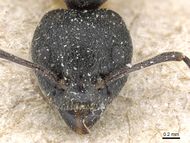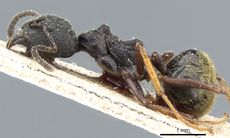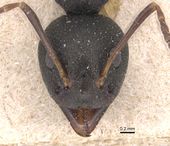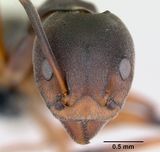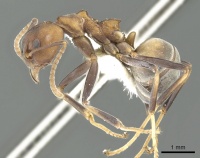Key to Dolichoderus cuspidatus group workers
You may also be interested in
- Dolichoderus
- Dolichoderus species groups
- Key to Dolichoderus groups for workers of Southeast Asia
- Key to Dolichoderus groups for queens of Southeast Asia
1
- Dorsum of head and alitrunk completely void of erect hairs, only bearing pubescence . . . . . 2
- Head and alitrunk dorsally with erect hairs; small species (HW 0.98-1.14 mm) (Borneo) . . . . . Dolichoderus pilinomas
2
return to couplet #1
- Mesonotum armed with a pair of blunt or pointed spines (figs. III-2d, III-4d, III-6, III-9d, III-9j-k) . . . . . 3
- Mesonotum without such spines, forming an unpaired, ± rounded hump that may be slightly depressed medially . . . . . 5
3
return to couplet #2
- Mesonotal spines very short and blunt, in full 1~1ce view, shape and length appearing ± similar to propodeal spines (MSL 0.23-0.28 mm, MSLI 18-22) (fig. III-2d) (N-Sumatra) . . . . . Dolichoderus brevithorax
- Mesonotal spines longer, mostly different in shape, longer and stouter than propodeal spines (MSL > 0.3 1 mm, MSLI > 24) . . . . . 4
4
return to couplet #3
- Propodeum slender (PpWminI = 17-28), bearing a pair of ± slender, coniform propodeal spines, which mostly are curved backwards apically and often are spatulately broadened at the top (figs . III-5a-j); anterior margin of mesopleuron usually with a distinct coniform process; upper margin of the petiole scale mostly emarginate (figs. III-5k-v) (Peninsular Malaysia, North Sumatra, Borneo?Java) . . . . . Dolichoderus cuspidatus
- Propodeum stouter (PpWminl = 27-33), propodeal spines plumper and broader (figs. III-9e, g, l-m); margin of mesopleuron without or at most with an indistinct, blunt protuberance; upper margin of petiole scale not or very weakly emarginate (figs. III-9f, h- i, n-o) (West Sumatra, Nias) . . . . . Dolichoderus furcifer
5
return to couplet #2
- Propodeum bearing a pair of long and slender spines or cornicles, which are pointed or spatulately broadened at the top (figs. III-3 and III-17) . . . . . 6
- Propodeum without such spines or cornicles, at most the upper, lateral corners of the propodeum expanded to broad and blunt cones (figs. III-7 and III-11) . . . . . 7
6
return to couplet #5
- Head (particularly on vertex) and alitrunk coarsely sculptured, i. e. the underlying fine punctation or reticulation is superimposed by coarser wrinkles that form a net of irregular, subcircular or suboval pits (areolate-rugose, fig. III-66); head distinctly wider than long (CI 107-116), often with a broad and deeply impressed superoccipital pit; propodeal spines, in dorsal view, laterally projecting out beyond the sides of the propodeum (PpSpI > 118) (fig. 17); large and robust (HW 1.6-2.1 mm) (Borneo) . . . . . Dolichoderus magnipastor
- Head and alitrunk only very finely punctate, reticulate, or imbricate, at most with shallow circular or oval impressions or slightly striate but not areolate-rugose (fig. III-57), head narrower (CI 95- 106), superoccipital pit not or only weakly developed; propodeal spines not laterally projecting beyond margin of propodeum (PpSpl < 96); of moderate size (HW 1.28- 1.86 mm) (fig. III-3) (Borneo) . . . . . Dolichoderus coniger
7
return to couplet #5
- The fine punctate or reticulate sculpturing of the head (particularly on the sides and/or vertex) is superimposed by a slightly coarser sculpturing that forms shallow, irregular subcircular, suboval or elongate pits (sub-areolate-rugose to areolate-rugose, figs. III-62 and III-65) . . . . . 8
- Head, particularly at the sides, only finely, ± evenly and densely punctate, reticulate or imbricate, not superimposed by a coarser sculpturing (figs. III-59 to III-61, III-63), at most a small areolate- rugose area behind the eye . . . . . 10
8
return to couplet #7
- Anterior portion of mesonotum, in profile view, forming a rounded, blunt conical hump, the anterior face of which ascending distinctly steeper than the dorsal face of the pronotum (fig. III-13b); often with distinctive, broad median superoccipital pit (fig. III-62) (especially in Peninsular Malaysia while only weakly developed or absent in West Sumatra) (Peninsular Malaysia, Sumatra) . . . . . Dolichoderus tuberifer
- Hump of mesonotum only with a gentle anterior slope, in profile view not distinctly steeper than dorsal face of pronotum (figs. III-12b, III-16b); superoccipital pit weakly developed or absent . . . . . 9
9
return to couplet #8
- Propodeum in profile steeply rising; propodeum (including mesopleura) almost as high as long; posterior margin of rising dorsal face of propodeum sharp, slightly overhanging the concave declivitous face (fig. III-12b) (Mentawei Islands: Sipora) . . . . . Dolichoderus modiglianii
- Propodeum less steep, in profile distinctly longer than high; transition between rising and declivitous face of propodeum ± bluntly rounded, its posterior margin usually not sharp and not overhanging the declivitous face (fig. III-16b) (Borneo) . . . . . Dolichoderus kinabaluensis
10
return to couplet #7
- Propodeum very steeply and high rising; propodeum (including mesopleura) at least as high as long, in profile view towering above the height of the mesonotum at least two times (fig. 14b); small species (HW 1.00-1.25 mm) (Borneo) . . . . . Dolichoderus pastorulus
- Propodeum shaped differently, not rising so steeply, usually longer than high . . . . . 11
11
return to couplet #10
- Upper lateral corners of propodeum expanded to blunt coniform processes (figs. III-7d-e, III-11d), which, in dorsal view, mostly point laterally and are distinctly larger than the propodeal stigmata (figs. III-7e, III-11c); head and entire alitrunk densely and ± evenly punctate; particularly mesonolum and propodeum, mostly even mesopleuron void of wrinkles or any coarser reticulate sculpturing (fig. 59), at most a few short wrinkles in the upper portion of the mesopleuron . . . . . 12
- Propodeum shaped differently, without distinct cone-like processes, at most corners slightly expanded to small lobes (fig. III-15e); the finely punctate or reticulate sculpturing of the alitrunk partly (especially on entire mesopleuron) superimposed by a coarser reticulate or striate (figs. III-60b, III-61b, III -63b, III-64b, III-65c) . . . . . 13
12
return to couplet #11
- The expanded, cone- like corners of the propodeum are broad and stout (PpSPpI 75-98) (figs. III-11c-d); in profile view, propodeum rises highly (PpHLI 83-97), usually towering above the mesonotum (fig. III-11b); posterior margin of the ascending dorsal face of the propodeum overhanging the s lightly concavely curved declivitous face (Fig. III- 11b) (Laos, Northeastern Thailand) . . . . . Dolichoderus laotius
- The expanded, cone-like corners of the propodeum are smaller (PpSPpI 62-76) (figs. III-7c-e); the propodeum rises lower (PpHLI 70-82) (fig. III-7b); the declivitous face of the propodeum, in profile view, beginning at the posterior margin of the ascending dorsal face, immediately curves vertically and backward, not bending concavely under the dorsal face that does not overhang; thus, the rising and the declivitous face almost form a right angle (fig. III-7b) (Vietnam, Northern Thailand) . . . . . Dolichoderus erectilobus
13
return to couplet #11
- Anterior portion of mesonotum, in profile view, forming a distinct, bluntly conical hump with a flattened top, the anterior face of which ascending distinctly steeper than the dorsal face of the pronotum (fig. III-15b); mesopleuron densely punctate, often with additional irregular sub-rugose-reticulate wrinkles, but without longitudinal, parallel wrinkles and furrows (fig. III-64b) (Borneo) . . . . . Dolichoderus maschwitzi
- Mesonotum, in profile view, only very slightly elevated without a distinct hump, or, if a hump is developed, then its anterior face not ascending steeper than the dorsal face of the pronotum (fig. III-8b, III- 10b); mesopleuron finely punctate with additional ± parallel, longitudinal wrinkles and furrows (fig. III-60b, III-61b) . . . . . 14
14
return to couplet #13
- Mesonotum hump, in profile view, low and flat, often with a median impression, in profile distinctly overtopped by the propodeum (fig. III-8b); dorsal face of pronotum with ± distinct anterior and lateral edges, pronotum shoulders rounded but ± distinct (fig. III-8c); declivitous face of propodeum initially curved vertically or even somewhat concavely under the posterior margin of the dorsal face (fig. III-8b) (Thailand, Myanmar, Sikkim) . . . . . Dolichoderus feae
- Mesonotum, in profile view, forming a distinct, rounded-coniform hump that is not or only very slightly overtopped by the propodeum (fig. III- 10b); lateral delimitation of dorsal face of pronotum without distinct edges, shoulders of pronotum indistinct (fig. III- 10c); posterior margin of rising dorsal face of propodeum not overhanging, i. e. the declivitous face immediately curves down and backwards rather than concavely under the edge (fig. III-10b) (Java) . . . . . Dolichoderus gibbifer












